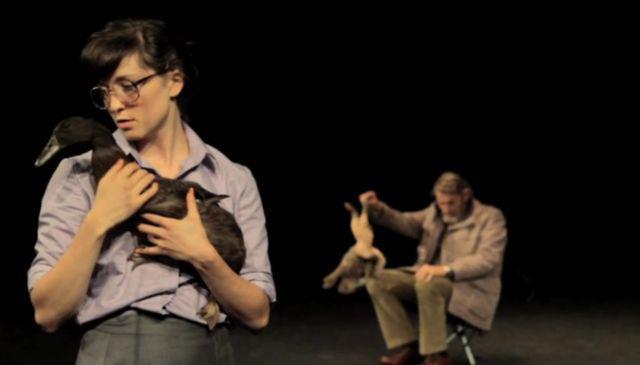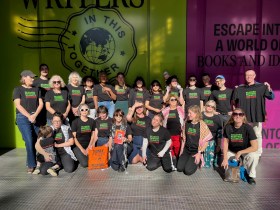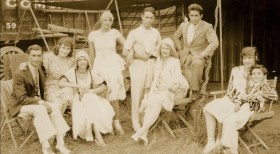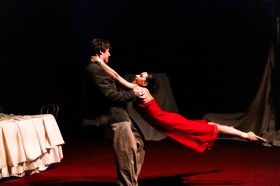I was at an opening night last week. A friend of mine, Jessi Lewis, was presenting his new performance work, Shattered, in a fashionable loft space in Melbourne’s Little Lonsdale Street. (Disclosure: I helped Lewis out with ideas in the script). Lewis had written and devised the work himself, with the help of some fine collaborators, such as director Yvonne Virsik and choreographer Tony Yap.
At the end of the show, Virsik and I had a conversation. ‘You know what that was,’ I said to her. ‘That was a new work.’
We shared a little chuckle, because what we really meant was: it wasn’t an adaptation. Here was a new idea, with a new script, new choreography, new staging – the lot. A genuine premiere, in other words. Not a re-staging, or a re-working, or a re-imagining. Just a new work. How refreshing!
The topic of new works has been on a lot of minds lately in the Australian theatre. The current debate stems from an incendiary article in The Australian by arts journalist Rosemary Neill, which examined the rash of adaptations and classic re-stagings currently playing on our main stage theatres.
The article is notable for a bombastic interview with the 28-year old wunderkind of Australian theatre, Simon Stone. Stone made his name with Melbourne indie company Hayloft with some ambitious adaptations of classic works, before moving to Belvoir in Sydney, where he also pursued ambitious adaptations of classic works. He’s since moved on from Belvoir for greener pastures as a freelance director. Right now, he’s just about the hottest thing in the entire Australian arts.
Neill’s article is about the avalanche of classics, and whether this is crowding out original scripts by Australian playwrights from our main stages. Not for the first time, Stone comes across as a bit of a tosser. ‘I’m stealing whatever I need to steal and corrupting whatever I need to corrupt to entertain an audience,’ he tells Neill. ‘I have no interest in honouring a set of ideas [an original playscript] that belong to the past of an audience.’
No doubt this is the inspiration behind the rather pretentious credits that have begun to appear on some of Stone’s productions, such ‘by Simon Stone after Anton Chekhov’. At least we’re under no illusions who’s getting top billing.
I remember seeing an early Hayloft show in a big warehouse in Footscray. It must have been the genesis of Stone’s re-working of The Cherry Orchard, to be produced in August by the Melbourne Theatre Company. Like Hayloft’s 3xsisters, produced in 2009, it was a striking and not completely-unfaithful engagement with a classic text. It seemed very fresh and original. What I didn’t realise at the time was that it was also a more or less rigid formula, which Stone has repeated ever since.
Stone’s approach to presenting classic material is best summed up by a couple of his better-known hits, Thyestes and The Wild Duck. Both productions were boldly conceived and staged, picking apart the plots of their chosen subjects to expose the narrative machinery underneath. Crucially, Stone completely rewrites the dialogue of his plays – often with literary collaborators such as Thomas Henning and Chris Ryan – re-presenting the characters in a laconic and demotic argot of everyday Australian life.
What shakes out is generally big, flashy and self-consciously emotive, as for instance in the penultimate scene of Thyestes, which would have rather put you off your pasta. But it is also undeniably decontextualised. In The Wild Duck, for instance, Stone kept the bare bones of Ibsen’s plot, straightened the through-line, and repopulated it with inner-city Australians (all of whom, rather unaccountably, kept their Nordic names). The acting was played as straight realism, but in the Malthouse version I saw, the set’s main feature – a big glass wall handsomely installed by Ralph Myers – rather mocked any realist pretensions. Like a lot of Stone’s work, the whole thing was very impressive. It was also intellectually confused.
That confusion is on vivid display later in Neill’s interview, when Stone seems to stumble over the thorny issue of why he keeps the titles to these classic works, if, as he says, they are really new works.
‘I suppose it’s a marketing technique,’ he admits, before contradicting himself and adding: ‘Titles are largely irrelevant.’ He goes on to tell [The Australian] that ‘every play ever written is a rewrite of something’, even if the work in question is a new play drawn from a dramatist’s life.
Stone’s most controversial recent effort was last year’s Belvoir version of Miller’s Death of a Salesman. Notoriously, Stone changed the ending, so that Willy gasses himself in his car (instead of dying in a crash that would allow his family to collect the insurance). He also cut the epilogue. After the estate of Arthur Miller got wind of the changes, Belvoir was forced to reinstate the original script. All in all, it wasn’t a great look.
In an essay penned for Belvoir about Death of a Salesman, Stone defends his decisions, not altogether coherently. ‘I brought the suicide onstage because we’ve all now witnessed the death of the dream, or more correctly we’re watching it dying,’ Stone writes. ‘So in my production we watch Willy die with it.’
Directors are directors, and we should judge them on their staged work, not their essays. Even so, there is something sadly retro about Stone’s love for the classics, and his belief that Australian reinterpretations mark some kind of new maturity for domestic theatre.
For students of the history of Australian culture, such sentiments are aching familiar. They are, quite simply, the cultural cringe, almost in its classic form. As originally coined by Australian critic A.A. Phillips back in 1950, ‘The Cringe mainly appears in a tendency to make needless comparisons. The Australian reader, more or less consciously, hedges and hesitates, asking himself, “Yes, but what would a cultivated Englishman think of all this?”’
If anything encapsulates the current craze in Australian theatre for bold new directions of northern hemisphere classics, it’s this idea of ‘needless comparisons’. International comparison is in fact how its main protagonists justify their project. Here is Stone, at the conclusion of his Belvoir essay:
Until recently we accepted the Broadway or West End way of treating their classics, now we are bringing to them an Australian sensibility and technique. The world is responding.
And here is Belvoir’s current Artistic Director, Ralph Myers, in an article in The Australian responding to the adaptation debate.
I wonder how Stone feels about all this? When I left him in Vienna on the weekend he was signing autographs for adoring fans of his adaptation of Henrik Ibsen’s The Wild Duck. It was the hit of the festival. Festival directors were lining up to meet him.
I wonder if he is tempted to stay in Europe, with his fellow exiles Barrie Kosky, Benedict Andrews and Simone Young, all of whom endured remarkably similar attacks in the Australian press before giving up and moving to the Continent to find success. It would be a real shame if Stone were to follow that path.
Myer’s article is disappointing in so many other ways, not least because of the entirely spurious argument he attempts to advance about baby boomers and their generational emnity.
But, for me, it was his insistence that the current debate was somehow illegitimate that was most saddening. Criticism, including in the media, is part and parcel of the practice of theatre. Neill’s article may have annoyed Simon Stone and Ralph Myers. But it was hardly an unwarranted ‘attack’. Indeed, similar sentiments have been floating around the Australian theatre scene for some time now, even as Stone’s star has ascended.
So let’s set a few things straight. Simon Stone is certainly very talented, and his works contain plenty of new writing. But they are not new works in any substantive sense. They are new versions of old works. Old works by playwrights that are neither living, nor Australian.
Is that a problem? Of course it’s not. Except if you’re an Australian playwright trying to get your work onto the main stage.





